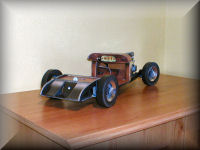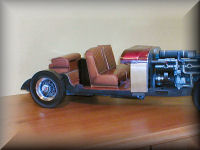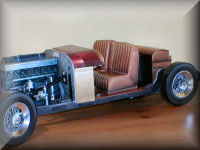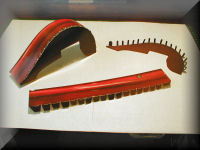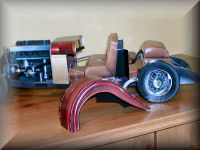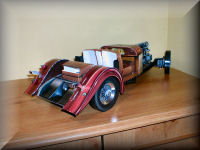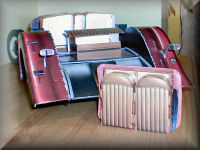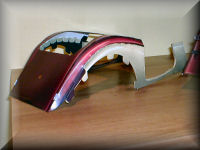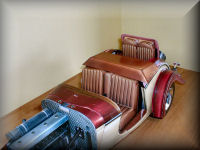
An Extinct Wrebbit
Mercedes-Benz 500K Roadster - Part II
in 1:10 scale
Built Art collection from Wrebbit
by Jeff Sissons
Model photographs by the author

CONSTRUCTION (Continued)
Welcome to the second instalment of this excellent 1:10 scale card
model. In Part I of this series we finished the steering and all the
associated brake drums and exhaust assemblies, and the car was
beginning to take shape. Let's continue from there.
5. The Wheels
You have two options to make up the six wheels. The first is described as the "easy" version; the second is the "hard" one! The hard version requires you to make a jig and to use the grey cotton thread that's provided to lace up the wheels to simulate spokes.
If you choose to go the "hard" route, the jig is made up to hold the center axle on which you slide a hub and the wheel rim to position it for lacing. Whether by accident or design, seven rims are given (extras to practice on?). With some trepidation, I chose to lace up the first wheel as a trial. To my surprise it laced up just as the numbered diagrams showed. And it looked pretty good after the cotton had been tied off.
The rim has fourteen notches around its circumference onto which the cotton is wound. The measurement of the length of cotton is accurate too, being cut at 64 inches. (Just enough! Allow a few more inches; there is plenty of cotton available.) In fact, half of the reel of cotton is left for the spares box. The cotton is of good quality and not at all "hairy."
So don't be put off by the label "hard." Try your hand on the spare first.
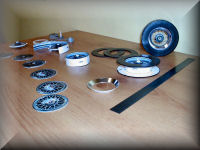
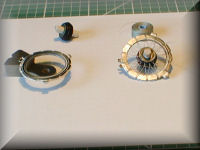 This photo shows the jig on the left, a prepared hub above that, the
reel of grey cotton (top right), and the test run bottom right. I
prepared six more of these before proceeding to the next stage of
fitting the rims, etc.
This photo shows the jig on the left, a prepared hub above that, the
reel of grey cotton (top right), and the test run bottom right. I
prepared six more of these before proceeding to the next stage of
fitting the rims, etc.
The next photo shows the build-up from the inner rim to the completed wheel, with the first chromed card used as the wheel trim insert.
So all went well, and the car sat on all four wheels without a wobble. The jig helped in this area. The rear wheels are glued to the axle, and the two front wheels are allowed to rotate freely. It just remains to build up the hub caps and glue these in place. That takes us to the end of Part 5.
6. The seats
This section starts with the rumble seat. Love that word! This is the passenger seat that folds down into the trunk/boot when not in use, and is behind the driver and front passenger seat.
This section is very small with only five model parts, and it is nice to start actually using parts for the car interior. The simulated leather look is well done, and I colored all the card edges with a brownish orange, which filled the bill very well.
Fitted to the car, the seats looked the part and I am almost inclined, If I do the model again, to fit a carpet for that added touch. But on this occasion I am building the kit straight from the Box.
7. The rear wings/fenders
Over half way. Seven out of twelve parts.
The joint of the wings is very cleverly achieved by a peg and slot method. It does hold everything firmly and requires only the smallest amount of glue to hold the pegs down. The first chromed parts are used in this section. These are two rear lamp cluster brackets, and just a word about those parts now. What to use to touch up the bare edges, as the chrome parts do make the car? I scratched my head for a while and then had a brainwave; I had a pot of Tamiya Color Acrylic paint - X11 Chrome silver. And using this with a small paint brush to touch up the edges of the chrome worked particularly well. Other model paint firms do make chrome silver paint, so it's worth a try. Using a colored felt tipped pen or water color pencil will of course do the job, but I personally like to try different approaches to a problem and pass the solutions on.
The wings (fenders) go together perfectly, but beware of mixing up the two. The two steps up to the rumble seat fit on the left wing and the single light bracket fits on the right wing.
The shape of each wing fits to the same outline on the chassis and that's that. We move onto the rear bodywork now.
8. The rear bodywork
This section starts with the construction of the rumble seat back, and the portion of the bodywork that will swivel down, hiding the rumble seat to create the cover to the trunk/boot. One of the last dowels is used in this stage and it is best to make sure that the dowel does in fact fit through all the holes in the brackets before the assemblies dry. The seat is built up section by section, until a very strong and moveable part is obtained. Two grab handles are mounted on the trunk lid to facilitate opening to reveal the interior rumble seat. Cool design....
Now the fun starts! The largest part H12, the rear body section, is npw joined to the two sides of the car. The two-color scheme now shows up and the cream against crimson looks very elegant. A fair amount of patience is required here to allow tags and tongues to dry, as the whole thing now becomes a bit unwieldy. The inner liners of the door frame provide a door stop, and the hole in the back of the trunk provides a position for the very final dowel to hold the last two spare wheels.
So now the final attachment of the body shell to the wings and to the front firewall area. All went well, and from the photos the completed part shows the section complete with striping, Rumble seat, spare wheels and soft-top cover.
That's that, until the next time when we move on to the final stages of this wonderful model. The hood/bonnet, front wings/fenders and the chromed accessories - not forgetting the windscreen. Until then, enjoy your modelling and have fun with the e-zine.
By the way, I have taken some measurements of the Mercedes for you: 20 inches long, 9 inches wide across the rear wings, and a height from the work surface of 6 inches. And it weighs in at about 1.5 lbs. Now that's some model car!
